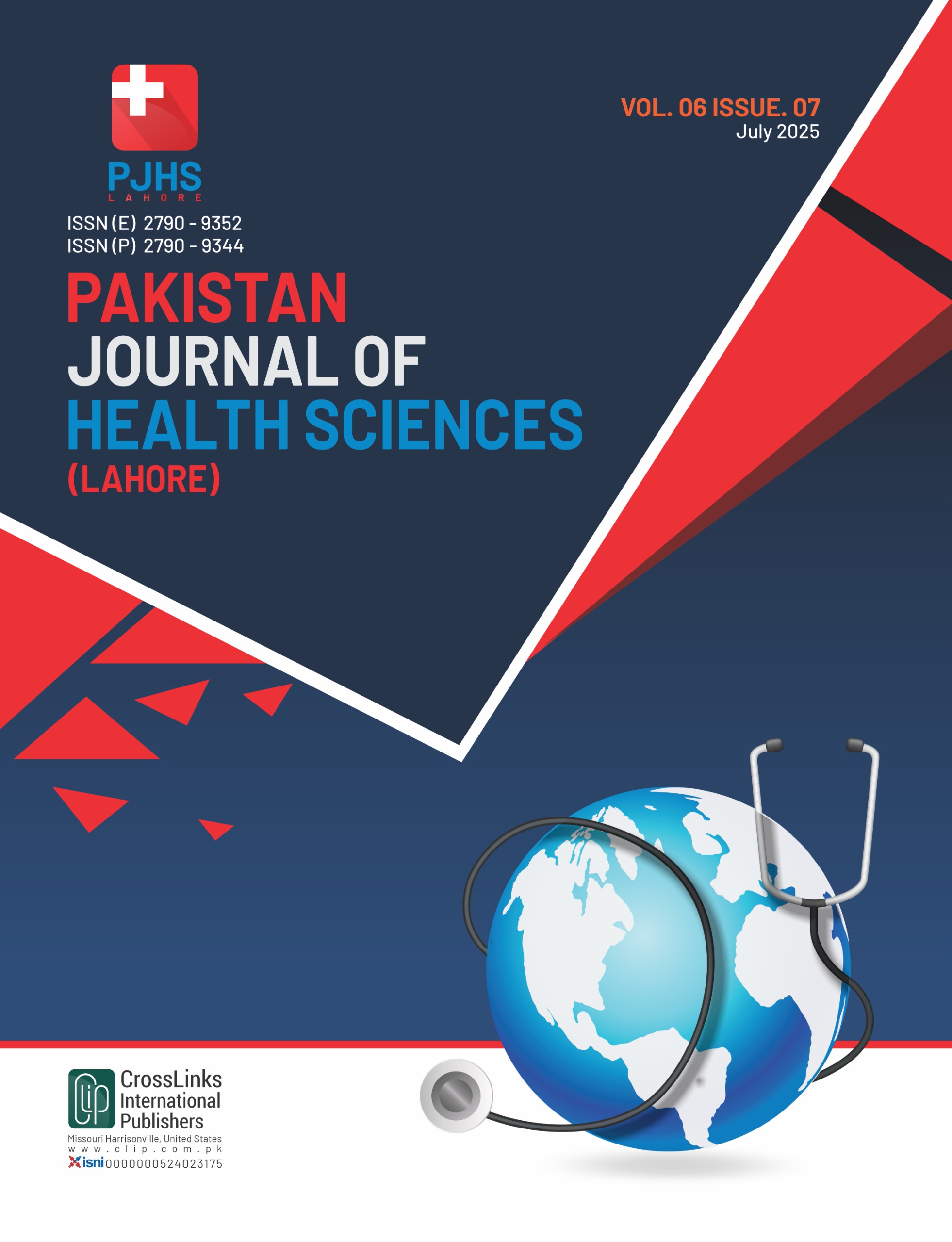Fetomaternal Outcome of Pregnant Women with Malaria
Fetomaternal Outcomes of Pregnant Women
DOI:
https://doi.org/10.54393/pjhs.v6i7.3124Keywords:
Anemia, Malaria, Low Weight, Preterm Birth, OutcomesAbstract
Malaria during pregnancy is a major public health concern, with devastating implications for both the mother and the unborn child. Objectives: To evaluate the maternal and fetal outcomes in pregnant women infected with Plasmodium falciparum and Plasmodium ovale/vivax. Methods: This descriptive cross-sectional study was carried out in Obstetrics and Gynecology Ward II using non-probability convenience sampling. It included 110 pregnant women diagnosed with malaria, excluding those with underlying health conditions. Data were gathered through interviews, medical records, and laboratory tests. Various maternal and neonatal factors, including hemoglobin levels and birth weight, were recorded. The chi-square test was performed to evaluate the relationship between malaria and fetal outcomes, with p-values<0.05 considered statistically significant. Results: Among 110 pregnant women, 58 (52.7%) were aged 21–30 years. The majority, 69 (62.7%), had 2–5 pregnancies, while 25 (22.7%) were primigravida. Preterm birth and full-term deliveries were equally distributed, 55 (50.0%), while anemia was prevalent in 82 (74.5%) of cases. Low birth weight was observed in 35 (31.8%) of neonates. Among 71 women with P. falciparum infection, 63 (88.7%) developed anemia, which was significantly higher than in the P. ovale/vivax group, where only 19 out of 39 (48.7%) were anemic (p<0.001). Preterm birth, 45 (63.4%) and low birth weight, 34 (47.9%), were significantly greater in falciparum cases (p<0.001). Conclusions: It was concluded that Plasmodium falciparum infection poses a higher frequency of adverse fetomaternal outcomes compared to Plasmodium ovale/vivax, characterized by noticeably greater incidences of hypoglycemia, low weight at birth weight, premature birth, and anemia.
References
Whittaker C, Slater H, Nash R, Bousema T, Drakeley C, Ghani AC et al. Global patterns of submicroscopic Plasmodium falciparum malaria infection: insights from a systematic review and meta-analysis of population surveys. The Lancet Microbe. 2021 Aug; 2(8): e366-74. doi: 10.1016/S2666-5247(21)00055-0. DOI: https://doi.org/10.1016/S2666-5247(21)00055-0
Reddy V, Weiss DJ, Rozier J, Ter Kuile FO, Dellicour S. Global estimates of the number of pregnancies at risk of malaria from 2007 to 2020: a demographic study. The Lancet Global Health. 2023 Jan; 11(1): e40-7. doi: 10.1016/S2214-109X(22)00431-4. DOI: https://doi.org/10.1016/S2214-109X(22)00431-4
Bakken L and Iversen PO. The impact of malaria during pregnancy on low birth weight in East-Africa: a topical review. Malaria Journal. 2021 Aug; 20(1): 348. doi: 10.1186/s12936-021-03883-z. DOI: https://doi.org/10.1186/s12936-021-03883-z
Khan MI, Qureshi H, Bae SJ, Khattak AA, Anwar MS, Ahmad S et al. Malaria prevalence in Pakistan: A systematic review and meta-analysis (2006–2021). Heliyon. 2023 Apr; 9(4). doi: 10.1016/j.heliyon.2023.e15373. DOI: https://doi.org/10.1016/j.heliyon.2023.e15373
Sato S. Plasmodium—a brief introduction to the parasites causing human malaria and their basic biology. Journal of Physiological Anthropology. 2021 Jan; 40(1): 1. doi: 10.1186/s40101-020-00251-9. DOI: https://doi.org/10.1186/s40101-020-00251-9
White NJ. Severe malaria. Malaria Journal. 2022 Oct; 21(1): 284. doi: 10.1186/s12936-022-04301-8. DOI: https://doi.org/10.1186/s12936-022-04301-8
Bhatti MA, Azharuddin M, Bhatti S, Islam M, Khan MA. Malaria and pregnancy: the perspective in Pakistan. Journal of Pakistan Medical Association. 2007; 57(1): 15.
Cowman AF, Healer J, Marapana D, Marsh K. Malaria: Biology and Disease. Cell. 2016 Oct; 167(3): 610-24. doi: 10.1016/j.cell.2016.07.055. DOI: https://doi.org/10.1016/j.cell.2016.07.055
Gontie GB, Wolde HF, Baraki AG. Prevalence and associated factors of malaria among pregnant women in Sherkole district, Benishangul Gumuz regional state, West Ethiopia. BMC Infectious Diseases. 2020 Dec; 20: 1-8. doi: 10.1186/s12879-020-05289-9. DOI: https://doi.org/10.1186/s12879-020-05289-9
Ahadzie-Soglie A, Addai-Mensah O, Abaka-Yawson A, Setroame AM, Kwadzokpui PK. Prevalence and risk factors of malaria and anaemia and the impact of preventive methods among pregnant women: A case study at the Akatsi South District in Ghana. PLOS One. 2022 Jul; 17(7): e0271211. doi: 10.1371/journal.pone.0271211. DOI: https://doi.org/10.1371/journal.pone.0271211
Chua CL, Khoo SK, Ong JL, Ramireddi GK, Yeo TW, Teo A. Malaria in pregnancy: from placental infection to its abnormal development and damage. Frontiers in Microbiology. 2021 Nov; 12: 777343. doi: 10.3389/fmicb.2021.777343. DOI: https://doi.org/10.3389/fmicb.2021.777343
Naserrudin NA, Lin PY, Monroe A, Culleton R, Baumann SE, Sato S et al. Exploring barriers to and facilitators of malaria prevention practices: a photovoice study with rural communities at risk to Plasmodium knowlesi malaria in Sabah, Malaysia. BioMed Central Public Health. 2023 Jul; 23(1): 1316. doi: 10.1186/s12889-023-16173-x. DOI: https://doi.org/10.1186/s12889-023-16173-x
Majumder S. Socioeconomic status scales: Revised Kuppuswamy, BG Prasad, and Udai Pareekh’s scale updated for 2021. Journal of Family Medicine and Primary Care. 2021 Nov; 10(11): 3964-7. doi: 10.4103/jfmpc.jfmpc_600_21. DOI: https://doi.org/10.4103/jfmpc.jfmpc_600_21
Zakama AK, Ozarslan N, Gaw SL. Placental malaria. Current Tropical Medicine Reports. 2020 Dec; 7(4): 162-71.doi: 10.1007/s40475-020-00213-2. DOI: https://doi.org/10.1007/s40475-020-00213-2
Goldstein JA, Gallagher K, Beck C, Kumar R, Gernand AD. Maternal-fetal inflammation in the placenta and the developmental origins of health and disease. Frontiers in Immunology. 2020 Nov; 11: 531543. doi: 10.3389/fimmu.2020.531543. DOI: https://doi.org/10.3389/fimmu.2020.531543
Fondjo LA, Addai Mensah O, Annani-Akollor ME, Quarshie JT, Boateng AA, Assafuah SE et al. A multicenter study of the prevalence and risk factors of malaria and anemia among pregnant women at first antenatal care visit in Ghana. PlOS one. 2020 Aug; 15(8): e0238077. doi: 10.1371/journal.pone.0238077. DOI: https://doi.org/10.1371/journal.pone.0238077
Schantz-Dunn J and Nour NM. Malaria and pregnancy: a global health perspective. Reviews in Obstetrics and Gynaecology. 2009; 2(3): 186.
Minja DT, Schmiegelow C, Oesterholt M, Magistrado PA, Boström S, John D et al. Reliability of rapid diagnostic tests in diagnosing pregnancy-associated malaria in north-eastern Tanzania. Malaria Journal. 2012 Dec; 11: 1-0. doi: 10.1186/1475-2875-11-211. DOI: https://doi.org/10.1186/1475-2875-11-211
Ullah H, Khan MI, Suleman SK, Javed S, Qadeer A, Nawaz M, Mehmood SA. Prevalence of malaria infection in district Dir lower, Pakistan. Punjab University Journal of Zoology. 2019; 34(2): 137-41. doi: 10.17582/journal.pujz/2019.34.2.137.141. DOI: https://doi.org/10.17582/journal.pujz/2019.34.2.137.141
Quinn JA, Munoz FM, Gonik B, Frau L, Cutland C, Mallett-Moore T et al. Preterm birth: Case definition & guidelines for data collection, analysis, and presentation of immunisation safety data. Vaccine. 2016 Dec; 34(49): 6047-56. doi: 10.1016/j.vaccine.2016.03.045. DOI: https://doi.org/10.1016/j.vaccine.2016.03.045
KC A, Basel PL, Singh S. Low birth weight and its associated risk factors: Health facility-based case-control study. PLOS ONE. 2020 Jun; 15(6): e0234907. doi: 10.1371/journal.pone.0234907. DOI: https://doi.org/10.1371/journal.pone.0234907
Cappellini MD and Motta I. Anemia in clinical practice—definition and classification: does hemoglobin change with aging? In Seminars in Hematology. 2015 Oct; 52(4): 261-269. doi: 10.1053/j.seminhematol.2015.07.006. DOI: https://doi.org/10.1053/j.seminhematol.2015.07.006
Silva CM, Arnegard ME, Maric-Bilkan C. Dysglycemia in pregnancy and maternal/fetal outcomes. Journal of Women's Health. 2021 Feb; 30(2): 187-93. doi: 10.1089/jwh.2020.8853. DOI: https://doi.org/10.1089/jwh.2020.8853
Satapathy P, Khatib MN, Gaidhane S, Zahiruddin QS, Sharma RK, Rustagi S et al. Adverse pregnancy outcomes in maternal malarial infection: A systematic review and meta-analysis. New Microbes and New Infections. 2024 Aug: 101474. doi: 10.1016/j.nmni.2024.101474. DOI: https://doi.org/10.1016/j.nmni.2024.101474
Thompson JM, Eick SM, Dailey C, Dale AP, Mehta M, Nair A et al. Relationship between pregnancy-associated malaria and adverse pregnancy outcomes: a systematic review and meta-analysis. Journal of tropical pediatrics. 2020 Jun; 66(3): 327-38. doi: 10.1093/tropej/fmz068. DOI: https://doi.org/10.1093/tropej/fmz068
Das JK, Lakhani S, Rahman AR, Siddiqui F, Padhani ZA, Rashid Z et al. Malaria in pregnancy: Meta-analyses of prevalence and associated complications. Epidemiology and Infection. 2024 Jan; 152: e39. doi: 10.1017/S0950268824000177. DOI: https://doi.org/10.1017/S0950268824000177
Danwang C, Bigna JJ, Nzalie RN, Robert A. Epidemiology of clinical congenital and neonatal malaria in endemic settings: a systematic review and meta-analysis. Malaria Journal. 2020 Dec; 19: 1-8. doi: 10.1186/s12936-020-03373-8. DOI: https://doi.org/10.1186/s12936-020-03373-8
Soomro P, Bhatti N, Abid K. Fetomaternal outcomes among pregnant females suffering from malaria, a study from Interior Sindh, Pakistan. Pakistan Journal of Medical Research. 2021 Oct; 60(3): 111-6.
Sohail M, Shakeel S, Kumari S, Bharti A, Zahid F, Anwar S et al. Prevalence of malaria infection and risk factors associated with anaemia among pregnant women in semiurban community of Hazaribag, Jharkhand, India. BioMed Research International. 2015; 2015(1): 740512. doi: 10.1155/2015/740512. DOI: https://doi.org/10.1155/2015/740512
Kassa GM, Muche AA, Berhe AK, Fekadu GA. Prevalence and determinants of anemia among pregnant women in Ethiopia; a systematic review and meta-analysis. BioMed Central Hematology. 2017 Dec; 17: 1-9. doi: 10.1186/s12878-017-0090-z. DOI: https://doi.org/10.1186/s12878-017-0090-z
Adam I, Ibrahim Y, Elhardello O. Prevalence, types and determinants of anemia among pregnant women in Sudan: a systematic review and meta-analysis. BioMed Central Hematology. 2018 Dec; 18: 1-8. doi: 10.1186/s12878-018-0124-1. DOI: https://doi.org/10.1186/s12878-018-0124-1
Lufele E, Umbers A, Ordi J, Ome-Kaius M, Wangnapi R, Unger H et al. Risk factors and pregnancy outcomes associated with placental malaria in a prospective cohort of Papua New Guinean women. Malaria Journal. 2017 Dec; 16: 1-0. doi: 10.1186/s12936-017-2077-4. DOI: https://doi.org/10.1186/s12936-017-2077-4
Leuba SI, Westreich D, Bose CL, Olshan AF, Taylor SM, Tshefu A et al. Effects on maternal and pregnancy outcomes of first-trimester malaria infection among nulliparous women from Kenya, Zambia, and the Democratic Republic of the Congo. PLOS ONE. 2024 Dec; 19(12): e0310339. doi: 10.1371/journal.pone.0310339. DOI: https://doi.org/10.1371/journal.pone.0310339
Moeller SL, Nyengaard JR, Larsen LG, Nielsen K, Bygbjerg IC, Msemo OA et al. Malaria in early pregnancy and the development of the placental vasculature. The Journal of Infectious Diseases. 2019 Sep; 220(9): 1425-34. doi: 10.1093/infdis/jiy735. DOI: https://doi.org/10.1093/infdis/jiy735
Accrombessi M, Yovo E, Fievet N, Cottrell G, Agbota G, Gartner A et al. Effects of malaria in the first trimester of pregnancy on poor maternal and birth outcomes in Benin. Clinical Infectious Diseases. 2019 Sep; 69(8): 1385-93. doi: 10.1093/cid/ciy1073. DOI: https://doi.org/10.1093/cid/ciy1073
Downloads
Published
How to Cite
Issue
Section
License
Copyright (c) 2025 Pakistan Journal of Health Sciences

This work is licensed under a Creative Commons Attribution 4.0 International License.
This is an open-access journal and all the published articles / items are distributed under the terms of the Creative Commons Attribution License, which permits unrestricted use, distribution, and reproduction in any medium, provided the original author and source are credited. For comments













